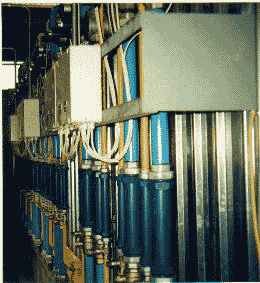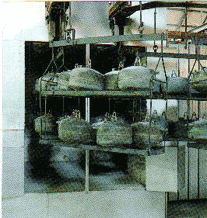Basically
two fabrication methods are used:
1
- tank body is let open on one side and bottom head is welded after
enamelling
2 - tank body is entirely welded before enamelling
The first method is usual in the U.S.A. and allows easier operations
for pretreatment, enamelling and control of the surface after coating
but two or more parts have to be separately enamelled, then assembled
and welded. Pretreatment by wheel-blasting and porcelain enamel application
by spraying are preferred techniques.
The second method, normally used for tanks to be galvanized, is traditionally
adopted in Europe. Pickling and flow-coating application are suitable
processing techniques for closed tanks with small bottom opening.
For tanks without coils or pipes inside, with adequate bottom head
slope and opening, blasting by compressed air nozzles and electrostatic
Powder Enamel application are practicable alternatives, even if not
cheap because of the higher equipment and operating costs of these
techniques. Porcelain Enamel powder is considerably more expensive
compared with frit.
In order to allow a proper automatic "Flowcoating" applica-tion of
Porcelain Enamel tanks must have possibly a cylindrical shape, free
spacing for the rollers on the outer cylinder body, external fixtures
if strictly necessary as small as possible and an adequate central
bottom head opening, whose diameter obviously determines both qua-lity
and time of application and drying. It is essential to recognize the
importance of a proper design for a satisfactory production of Porcelain
Enamelled boilers. Improper design is responsible for more difficulties
in the enamelling process than faulty processing itself. Selection
of the proper gage of steel is very important as well as the quality
of steel, the absence of harmful impurities, structural defects, inclusions,
etc.
As boiler tanks cannot be formed from one piece of steel, welding
is necessary to obtain the complete shape. Different types of welding
are acceptable for porcelain enamelling. Welding equipment manufactures
should be consulted for choice of proper procedure, which has to be
carefully tested for compatibility with Porcelain Enamel coating before
adoption.
Gage of lugs and clips which are spot welded to the outside of boilers
should be thinner than the boiler sheet and the double thickness area
of contact should be as small as possible. This will reduce danger
of underfiring at the points where such attach-ments are welded.



